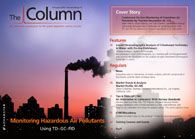Oil Sheen Mystery Solved by GCXGC Analysis
Comprehensive two-dimensional gas chromatography (GCXC) has been performed to identify the origins of a mysterious oil sheen in the Gulf of Mexico, first reported in September 2012. The results have been published in the journal Environmental Science and Technology1 by researchers from the University of California (California, USA) and the Wood Hole Oceanographic Institute (WHOI) (Massachusetts, USA).

Comprehensive two-dimensional gas chromatography (GCXGC) has been performed to identify the origins of a mysterious oil sheen in the Gulf of Mexico, first reported in September 2012. The results have been published in the journal Environmental Science andTechnology1 by researchers from the University of California (California, USA) and the Wood Hole Oceanographic Institute (WHOI) (Massachusetts, USA).
The sheen was reported close to the Deepwater Horizon disaster site in the Gulf of Mexico. An explosion on the Deepwater Horizon oil platform during the drilling of the Macondo oil well in April 2010 resulted in the release of nearly 5 million barrels of oil into the Gulf of Mexico.1
Report of the sheen initially sparked concerns that the capped well had begun to leak; however, by using a patented methodutilizing comprehensive GCXGC, the team was able to prove that this was not the case. David L. Valentine of the Universityof California (California, USA) told The Column that the work shows that the sheen is not originating from the well itself and,although welcome news, it serves as a warning that the oil from the disaster still persists.
The team collected 14 sheen samples from the surface of the gulf for fingerprinting with GCXGC, which were then compared against samples collected at the time of the disaster and in the years following.
Valentine told The Column that the sampling was not as easy as might be assumed. He commented: “The site is far from landand it was rough going to collect samples offshore in the winter — we almost didn’t make it there on one of our trips. And theforensic sleuthing we needed to do was also quite a challenge — the chemistry was not simple.”
Christoph Aeppli (WHOI) told The Column: “We were able to detect small amounts of olefins, man-made chemicals used indeep sea drilling in the samples, in oil sheen samples.” He added: “It is generally challenging to detect single target compoundsin the thousands of oil hydrocarbons using traditional GC analysis. We therefore used comprehensive two-dimensional GC(GCXGC) that allowed us to identify and even quantify olefins amounting to less than 0.1% of the total hydrocarbons for mostsamples.”
The presence of olefins in the samples meant that the team could rule out the Macondo well and other natural seeps. The authors concluded that the oil sheen must originate from the wreckage of the oil platform. At the time of the explosion the platform contained barrels of oil and mud mixtures from drilling the well that the authors hypothesized were being released into the sea by the corrosion of the barrels by the seawater. According to Aeppli, this is good news because this oil is a finite volume.
The study demonstrated the forensic application of drilling mud olefin analysis in the identification of oil sheens. Aeppli told TheColumn that the method was in fact first developed for analysing oil extracted from a newly drilled well, as olefin contaminationis a common problem. A method first developed and patented with the oil industry in mind has subsequently been proven usefulin environmental monitoring.
Reference
1. C. Aeppli, C. Reddy, R.K. Nelson, M.Y. Kellermann, and D.L. Valentine, Environmental Science and Technology DOI: 10.1021/es4024139 (2013).
This story originally appeared in The Column. Click here to view that issue.

Best of the Week: Food Analysis, Chemical Migration in Plastic Bottles, STEM Researcher of the Year
December 20th 2024Top articles published this week include the launch of our “From Lab to Table” content series, a Q&A interview about using liquid chromatography–high-resolution mass spectrometry (LC–HRMS) to assess chemical hazards in plastic bottles, and a piece recognizing Brett Paull for being named Tasmanian STEM Researcher of the Year.
Using LC-MS/MS to Measure Testosterone in Dried Blood Spots
December 19th 2024Testosterone measurements are typically performed using serum or plasma, but this presents several logistical challenges, especially for sample collection, storage, and transport. In a recently published article, Yehudah Gruenstein of the University of Miami explored key insights gained from dried blood spot assay validation for testosterone measurement.
Determination of Pharmaceuticals by Capillary HPLC-MS/MS (Dec 2024)
December 19th 2024This application note demonstrates the use of a compact portable capillary liquid chromatograph, the Axcend Focus LC, coupled to an Agilent Ultivo triple quadrupole mass spectrometer for quantitative analysis of pharmaceutical drugs in model aqueous samples.